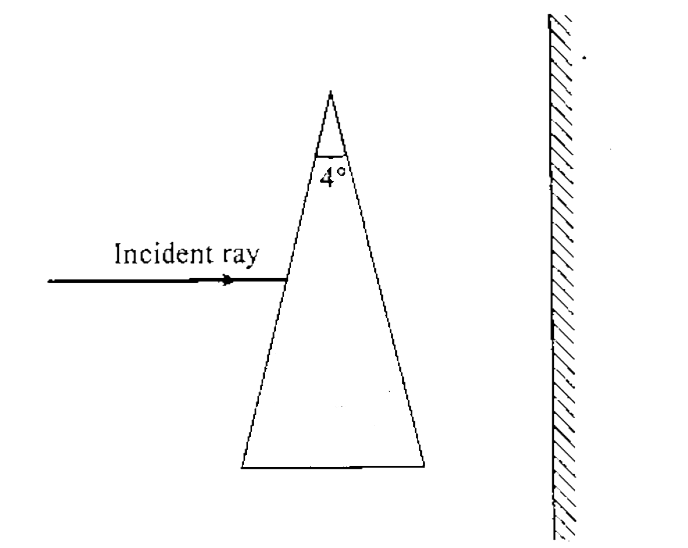In the given figure a parallel beam of ligth is incident on the upper part of a prism of angle 1.8∘ and R.I.3/2 . The light coming out of the prism falls on a concave mirror of radius of curvature 20cm. The distance of the point (where the rays are focused after reflrction from the mirror) from the pricipal axis is: [use π=3.14]
![In the given figure a parallel beam of ligth is incident on the upper part of a prism of angle 1.8^(@) and R.I.3//2 . The light coming out of the prism falls on a concave mirror of radius of curvature 20 cm. The distance of the point (where the rays are focused after reflrction from the mirror) from the pricipal axis is: [use pi=3.14]](https://d10lpgp6xz60nq.cloudfront.net/physics_images/RES_OPT_PHY_XII_C01_E01_089_Q01.png)
9cm
1.57mm
3.14mm
none of these
The correct Answer is:B
N//a
Topper's Solved these Questions
- GEOMATRICAL OPTICS BOOK - RESONANCECHAPTER - GEOMATRICAL OPTICS EXERCISE - Exercise-3
79 Videos
- GEOMATRICAL OPTICS BOOK - RESONANCECHAPTER - GEOMATRICAL OPTICS EXERCISE - Advance level Problems
35 Videos
- GEOMATRICAL OPTICS BOOK - RESONANCECHAPTER - GEOMATRICAL OPTICS EXERCISE - Exercise-1
142 Videos
- EXPERIMENTAL PHYSICSBOOK - RESONANCECHAPTER - EXPERIMENTAL PHYSICSEXERCISE - PART -II
10 Videos
- GRAVITATIONBOOK - RESONANCECHAPTER - GRAVITATIONEXERCISE - HIGH LEVEL PROBLEMS
16 Videos
Similar Questions
A parallel paraxial beam of light is incident on the arrangement as shown (μA=3/2,μB=4/3). The two spherical surfaces are very close and each has a radius of curvature 10 cm. Find the point where the rays are focussed. (w.r.t. point of entry)

View SolutionFigure shows a small angles prism angle 4∘and μ=32. A light ray almost normally incident on the prism is refracted and falls on a vertical mirror as shown. Find the total deviation of the ray after reflection from the mirror.

View Solution
Knowledge Check
A point object at 15 cm from a concave mirror of radius of curvature 20 cm is made to oscillate along the principal axis with amplitude 2 mm. The amplitude of its image will be
A2mmB4mmC8mmDNone of theseA ray parallel to principal axis is incident at 30∘ from normal on concave mirror having radius of curvature R. The point on principal axis where rays are focussed is Q such that PQ is
 AR2BR√3C2√R−R√2DR(1−1√3)
AR2BR√3C2√R−R√2DR(1−1√3)Parallel rays of light are falling on convex sphere surface of radius of curvature R = 20 cm as show. Refractive index of the medium is μ=1.5. A refraction from the spherical surface parallel rays
 Aactually meet at some pointBappear to meet after extending the refracted rays backwardsCmeet (or appear to meet) at a distance of 30 cm from the spherical surfaceDmeet (or appear to meet) at a distance of 60 cm from the spherical surface.
Aactually meet at some pointBappear to meet after extending the refracted rays backwardsCmeet (or appear to meet) at a distance of 30 cm from the spherical surfaceDmeet (or appear to meet) at a distance of 60 cm from the spherical surface.
Sunlight is incident on a concave mirror, parallel to its principal axis. The image is formed at a distance of 12cm from the pole. Find the radius of curvature of the mirror.
View SolutionA point light source lies on the principal axis of concave spherical mirror with radius of curvature 160 cm. Its image appears to be back of the mirror at a distance of 70 cm from mirror. Determine the location of the light source.
View SolutionFor a concave mirror, paraxial rays are focused at distance R2 from pole and marginal rays are focused at distance x from pole, then (R is radius of curvature)
View SolutionA ray of light is incident on a concave mirror . It is parallel to the principal axis and its height from principal axis is equal to the focal length of the mirror. The ratio of the distance of point B to the distance of the focus from the centre of curvature is (AB is the reflected ray)
_E01_055_Q01.png)
View SolutionA point object at a distance 5R/3 from the pole of a concave mirror. R is the radius of curvature of mirror. Point object oscillates with amplitude of 1mm perpendicular to the principal axis.

The amplitude of image is
View Solution
